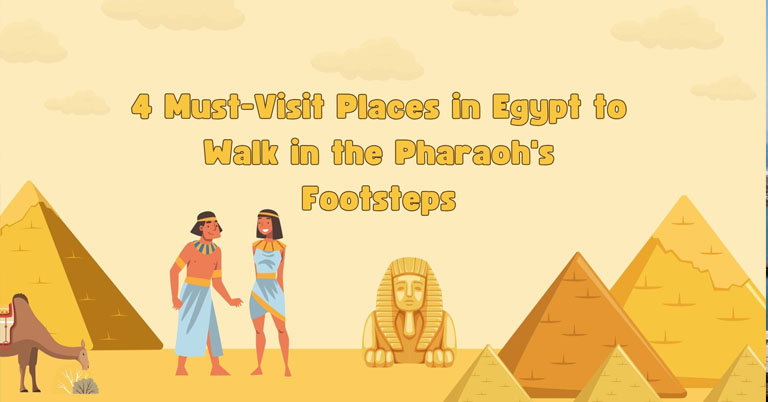Egypt, the land of the pharaohs, is a treasure trove of ancient wonders waiting to be explored. For history enthusiasts and travel aficionados, walking in the footsteps of the pharaohs is a dream come true. In this travel guide, we delve into four must-visit destinations that offer an enriching journey through time: the Great Pyramid of Giza, the Valley of the Kings, the Temple of Karnak, and Abu Simbel. These iconic sites not only showcase architectural marvels but also provide a profound understanding of ancient Egyptian civilization.

The Great Pyramid of Giza: A Marvel of Ancient Engineering
The Great Pyramid of Giza, one of the Seven Wonders of the Ancient World, stands as a testament to the ingenuity and ambition of ancient Egypt. Built during the reign of Pharaoh Khufu around 2580–2560 BC, this colossal structure continues to captivate the imagination of visitors from around the globe.
Standing at an original height of 146.6 meters, the Great Pyramid was the tallest man-made structure in the world for over 3,800 years. Its precise alignment with the cardinal points and the sheer scale of its construction using over 2 million limestone blocks demonstrates the advanced engineering skills of the ancient Egyptians.

Best time to visit: Early morning or late afternoon to avoid the midday heat. Insider tip: Hire a knowledgeable guide to uncover the pyramid’s hidden secrets and enhance your experience.
The Valley of the Kings: The Eternal Resting Place of Pharaohs
Located on the west bank of the Nile near Luxor, the Valley of the Kings is an archaeological wonder that served as the royal burial ground for pharaohs of the New Kingdom (16th to 11th centuries BC). This site is home to over 60 tombs, including the famous tomb of Tutankhamun.
Visitors can explore these intricately decorated tombs adorned with hieroglyphics and vivid wall paintings that depict scenes from the pharaohs’ journey to the afterlife. The discovery of Tutankhamun’s tomb by Howard Carter in 1922 remains one of the most significant archaeological finds of all time.

Best time to visit: Early morning to beat the crowds and the heat. Insider tip: Purchase a separate ticket for the tomb of Tutankhamun for a closer look at the treasures of the boy king.
The Temple of Karnak: A Grand Showcase of Ancient Egyptian Architecture
The Temple of Karnak, located in Luxor, is a vast complex dedicated to the Theban triad of Amun, Mut, and Khonsu. This sprawling site covers over 200 acres and includes a series of temples, chapels, pylons, and obelisks, making it one of the largest religious complexes in the world.
The most iconic feature of Karnak is the Great Hypostyle Hall, an awe-inspiring forest of 134 massive columns that reach heights of up to 24 meters. The temple’s construction spanned over 1,500 years, with contributions from numerous pharaohs, including Ramses II and Hatshepsut.

Best time to visit: Late afternoon for a magical sunset experience. Insider tip: Attend the mesmerizing Sound and Light Show for an immersive journey through the temple’s history.
Abu Simbel: The Monumental Temples of Ramses II
Abu Simbel, located in southern Egypt near the Sudanese border, is renowned for its two massive rock temples built by Pharaoh Ramses II in the 13th century BC. These temples were relocated in the 1960s to save them from the rising waters of the Aswan High Dam.
The Great Temple of Ramses II features four colossal statues of the pharaoh, each standing at 20 meters tall, guarding the entrance. Inside, the temple is adorned with intricate carvings and reliefs depicting Ramses’ military victories. The smaller temple, dedicated to Queen Nefertari, is equally impressive with its stunning facade and interior decorations.

Best time to visit: Early morning to witness the sunrise illuminating the statues. Insider tip: Plan your visit during the biannual solar alignment phenomenon when the sun’s rays penetrate the temple’s inner sanctuary.
Plan Your Journey to Egypt
Visiting these ancient sites offers a unique opportunity to connect with the rich history and culture of Egypt. To make the most of your trip, consider the best times to visit, hire knowledgeable guides, and take advantage of insider tips. Whether you’re exploring the iconic pyramids, the sacred tombs, or the grand temples, each destination promises an unforgettable adventure in the land of the pharaohs.
Embark on your journey to Egypt and walk in the footsteps of the pharaohs. The ancient wonders await!
